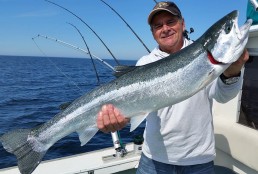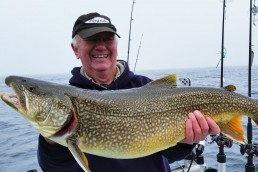Steelhead: Fish of the Future for Lake Michigan?
SHARE THIS POST
It was a pretty intense sunrise when the crimson fireball that snuck up on the horizon an hour earlier turned to a bright yellow and climbed higher. The morning bite produced a handful of kings, but the calm seas and bright sunshine cut off the fun a bit prematurely. As I turned the Grand Illusion 2 easterly, I pushed the throttle a bit forward and kicked the speed up a few tenths of a knot. Trevor had started setting out a few high Yellow Bird sets with some brighter silver and orange spoons.
Trevor hooked up the second Yellow Bird and slipped it in the water.
“Fish on! Far Yellow Bird!—Look at him jump!”
That didn’t take long; Trevor handed the rod he just set to the customer and raced back to the other side.
“Another one! Look at the other far Yellow Bird!”
A steelhead skied out of the water with the R & R flamethrower dangling in its mouth.
“I told you they were still here!” exclaimed Trevor, as he readied the net to scoop the first steelie.
As the morning rolled on, we captured one half-dozen steelhead, a lake trout and a couple more medium kings. The cooler didn’t look bad for a mid-June morning.
The larger rain events that we have had this off-season have shown the promise of potential larger year-classes due to blooms in alewife food supplies. The good news is that we are still planting salmon and trout, and numbers are right on track with planting goals set forth three years ago. There have been meetings with reports producing some positive news about our fisheries.
Are you enjoying this post?
You can be among the first to get the latest info on where to go, what to use and how to use it!
Wisconsin’s west shores of Lake Michigan once again showed good numbers of fish caught, specifically the area north of Manitowoc and south of Baileys Harbor. These captured top numbers of chinooks and steelhead. In fact, the ports of Algoma and Kewaunee have been the top producers for chinooks for 20 straight years and the top steelhead areas for 14 straight years. Strong prevailing wind patterns and currents, keeping baitfish close to the bottom structure, aided these locations. And, significant planting sites within these areas also help make this a hot spot.
In addition to hearing about natural reproduction of the chinooks, we were recently brought up to speed on the progress of the lake trout planting and restoration goals. Two of the three major planting locations in Lake Michigan have seen significant natural reproduction and strong numbers of lake trout caught by anglers on the west shore have been naturals—a very good sign that efforts to reestablish a sustainable population of lake trout is paying off.
The past couple seasons we’ve seen our lake and rivers swell and the Lake Michigan water levels above normal. This has not only been welcome to communities to decrease the need to dredge harbors and marinas, but it has also created outstanding fishing opportunities for shore and stream anglers. They have had good runs of salmon and trout in the tributaries. Another great sign for the fishery is that some of the best steelhead fishing in the tributaries occurred this spring. In the past, that has translated into very good trolling opportunities later on.
Targeting steelhead is relatively easy and some of the most fun fishing. Being a sight- feeding fish, steelhead are best targeted near the surface using in-line planer boards and bright, shiny spoons. These aerobatic fish love to smack flashy spoons trolled in the upper 25 feet of the water column; they jump, twist and tail-dance all the way to the boat.
Because of the clear water, steelhead are easily spooked by the boat, so keeping your lures far from the vessel is key. Yellow Bird in-line planer boards keep my shiny spoons as wide and far from the boat as possible. Spoons with silver and orange, silver and pink and orange and gold patterns are top producers, but occasionally watermelon, muskmelon and union spoon colors get hot.
Over the past decade, the planting numbers have become a little more balanced between the species, and with steelhead and trout being repeat spawners and living longer than salmon, I am seeing a much more balanced fishery with steelhead playing a larger role as a targeted species. Watching a steelhead smack a flamethrower behind my planer board and dance and twist on the surface never gets old.
Capt. Lee Haasch is a charter captain out of Algoma, Wis. Capt. Lee has over 40 years of Great Lakes angling experience and has been instructing anglers for over 25 years with education seminars and timely freelance articles in outdoor publications.
For more information…
For current fishing reports or information on charter fishing check out Capt. Lee Haasch’s report page at FishAlgoma.com.
MWO
SHARE THIS POST
Did you enjoy this post?
You can be among the first to get the latest info on where to go, what to use and how to use it!
Lee Haasch
Capt. Lee Haasch is a charter captain out of Algoma, Wis., with more than 45 years of Great Lakes angling and guiding experience. Haasch has been instructing anglers for over 30 years with education seminars and timely freelance articles.



